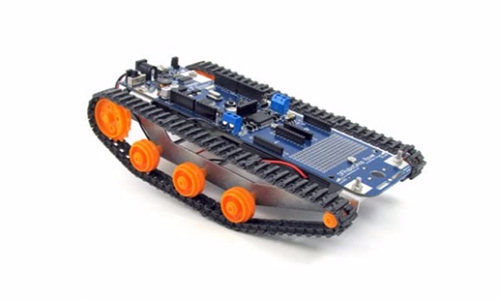Rsearchers of Freie Universität Berlin, of the Bernstein Fokus Neuronal Basis of Learning, and of the Bernstein Center Berlin and have developed a robot that perceives environmental stimuli and learns to react to them. The scientists used the relatively simple nervous system of the honeybee as a model for its working principles. To this end, they installed a camera on a small robotic vehicle and connected it to a computer. The computer program replicated in a simplified way the sensorimotor network of the insect brain. The input data came from the camera that-akin to an eye-received and projected visual information. The neural network, in turn, operated the motors of the robot wheels-and could thus control its motion direction.
The outstanding feature of this artificial mini brain is its ability to learn by simple principles. “The network-controlled robot is able to link certain external stimuli with behavioral rules,” says Professor Martin Paul Nawrot, head of the research team and professor of neuroscience at Freie Universität Berlin. “Much like honeybees learn to associate certain flower colors with tasty nectar, the robot learns to approach certain colored objects and to avoid others.”
In the learning experiment, the scientists located the network-controlled robot in the center of a small arena. Red and blue objects were installed on the walls. Once the robot’s camera focused on an object with the desired color — red, for instance — , the scientists triggered a light flash. This signal activated a so-called reward sensor nerve cell in the artificial network. The simultaneous processing of red color and the reward now led to specific changes in those parts of the network, which exercised control over the robot wheels. As a consequence, when the robot “saw” another red object, it started to move toward it. Blue items, in contrast, made it move backwards. “Just within seconds, the robot accomplishes the task to find an object in the desired color and to approach it,” explains Nawrot. “Only a single learning trial is needed, similar to experimental observations in honeybees.”
The current study was carried out at Freie Universität Berlin within an interdisciplinary collaboration between the research groups “Neuroinformatics” (Institute of Biology) led by Professor Martin Paul Nawrot and “Artificial Intelligence” (Institute of Computer Science) led by Professor Raúl Rojas. The scientists are now planning to expand their neural network by supplementing more learning principles. Thus, the mini brain will become even more powerful-and the robot more autonomous.
The Bernstein Focus “Neuronal Basis of Learning” with its project “Insect inspired robots: towards an understanding of memory in decision making” and the Bernstein Center Berlin are part of the National Bernstein Network Computational Neuroscience in Germany. With this funding initiative, the German Federal Ministry of Education and Research has supported the new discipline of Computational Neuroscience since 2004 with more than 170 million Euros.The network is named after the German physiologist Julius Bernstein (1835-1917).
Story Source:
The above story is based on materials provided by Freie Universitaet Berlin.





